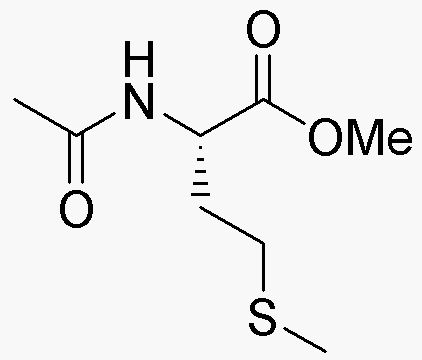Acetyl-L-methionine methyl ester is widely utilized in research focused on:
- Pharmaceutical Development: This compound is explored for its potential therapeutic effects, particularly in formulations aimed at liver health and detoxification.
- Nutritional Supplements: It is incorporated into dietary supplements due to its role in supporting metabolic processes and enhancing overall wellness.
- Cosmetic Formulations: The compound is used in skincare products for its antioxidant properties, helping to protect skin cells from oxidative stress.
- Agricultural Applications: It is investigated for use in plant growth regulators, promoting healthier crop yields and improving resistance to environmental stressors.
- Research on Aging: Studies are being conducted to assess its potential in anti-aging products, focusing on its ability to support cellular health and longevity.
General Information
Properties
Safety and Regulations
Applications
Acetyl-L-methionine methyl ester is widely utilized in research focused on:
- Pharmaceutical Development: This compound is explored for its potential therapeutic effects, particularly in formulations aimed at liver health and detoxification.
- Nutritional Supplements: It is incorporated into dietary supplements due to its role in supporting metabolic processes and enhancing overall wellness.
- Cosmetic Formulations: The compound is used in skincare products for its antioxidant properties, helping to protect skin cells from oxidative stress.
- Agricultural Applications: It is investigated for use in plant growth regulators, promoting healthier crop yields and improving resistance to environmental stressors.
- Research on Aging: Studies are being conducted to assess its potential in anti-aging products, focusing on its ability to support cellular health and longevity.
Documents
Safety Data Sheets (SDS)
The SDS provides comprehensive safety information on handling, storage, and disposal of the product.
Product Specification (PS)
The PS provides a comprehensive breakdown of the product’s properties, including chemical composition, physical state, purity, and storage requirements. It also details acceptable quality ranges and the product's intended applications.
Certificates of Analysis (COA)
Search for Certificates of Analysis (COA) by entering the products Lot Number. Lot and Batch Numbers can be found on a product’s label following the words ‘Lot’ or ‘Batch’.
Numéro de catalogue
Numéro de lot/série
Certificates Of Origin (COO)
This COO confirms the country where the product was manufactured, and also details the materials and components used in it and whether it is derived from natural, synthetic, or other specific sources. This certificate may be required for customs, trade, and regulatory compliance.
Numéro de catalogue
Numéro de lot/série
Safety Data Sheets (SDS)
The SDS provides comprehensive safety information on handling, storage, and disposal of the product.
DownloadProduct Specification (PS)
The PS provides a comprehensive breakdown of the product’s properties, including chemical composition, physical state, purity, and storage requirements. It also details acceptable quality ranges and the product's intended applications.
DownloadCertificates of Analysis (COA)
Search for Certificates of Analysis (COA) by entering the products Lot Number. Lot and Batch Numbers can be found on a product’s label following the words ‘Lot’ or ‘Batch’.
Numéro de catalogue
Numéro de lot/série
Certificates Of Origin (COO)
This COO confirms the country where the product was manufactured, and also details the materials and components used in it and whether it is derived from natural, synthetic, or other specific sources. This certificate may be required for customs, trade, and regulatory compliance.


